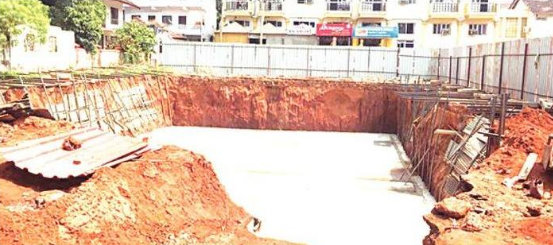
Sujay Gupta
The village of Calangute, with its beach called the ‘queen of the beaches’, is a beauty which is frazzled, its wrinkles evident from the disappearing sands and the tsunami of concrete, from the waves of crass development to the roar of politics. Even the ocean seems mute to shenanigans of the greedy.
As the week drew to a close the Calangute Panchayat passed a resolution asking for their village to be de-notified from the list of 56 villages that were reclassified as urban areas and notified. While public pressure forced the government to do a rethink on this, Calangute was again in the forefront asking for the village to be notified as an urban area. As a result of this, the village was yet again classified as “urban” earlier this month, much to the absolute shock of the locals. At that time the Local MLA and minister Michael Lobo had said “Buildings came up in Calangute even before I became the MLA. One should check when Calangute was declared an urban area. It’s on the census. It is only that the State government has notified it now. Locals will benefit from the urban status and will thank the government for it later”.
Less than two weeks later, there was an about-turn on Thursday. “The panchayat body has passed a unanimous resolution to write to concerned authorities to de-notify Calangute as urban area as the villagers had several apprehensions the change in status will invite an increase in taxes, FAR among other changes,” said Sarpanch Shawn Martin.
Minister Lobo then welcomed the decision saying that he was with the people.
But beneath statements and the rough roller coaster ride that Calangute seems to be going through, with a confused identity crisis of being urban and then “rural”, the elephant in the room, which is being cleverly not addressed, is that Calangute still falls under the Outline Development Plan, which has been drawn by the North Goa Planning and Development Authority. And as long as it is under the ODP the march of reckless urbanisation will continue.
How can the people of Calangute forget that its panchayat had moved the High Court against the inclusion of the village under the ODP in 2016? The next panchayat which got elected promptly decided to withdraw the case. Every local in Calangute knows the reason why. There were several panch members who had deep commercial interests and were owners of real estate. The ODP would give them additional FARs. Minister Michael Lobo also keeps no secrets of his ownership and stakes in hotels and real estate.
With such a major conflict of interest dominating elected representatives from the panch to the Minister, can there be an honest assessment of Calangute’s needs? Can we trust lobbies with vested interests, hobnobbing with the real estate and construction lobby to actually protect Calangute from becoming an absolute concrete mess, which it has become?
The classification as urban happens due to a census criteria, classifying areas with more than 5000 people per square kilometres and with more than 75% of its people engaged in non-agricultural activities as “urban areas”. But it is the ODP prepared by the Planning and Development Authority that grants FARs construction licences and plans to convert swathes of land into commercial zones.
Has the Calangute panchayat challenged the ODP? No. Has it since it withdrew the court case filed against the ODP approached the court again? No
Real action such as these have not been taken, and lip service is being paid by getting one village panchayat in the constituency to pass a resolution to de-urbanise Calangute.
At the same time, we also need to understand the motive behind the “urbanisation” classification is more than a simple classification exercise. And to explain this, this writer craves liberty to quote from his own piece written in 2020 in these very columns:
“The list of villages now in urban areas include some of the most pristine coastal villages as well as untouched patches of green villages in the interiors of Goa, with a gorgeous rural landscape untainted by urbanisation, paddy fields and rivers.
The ostensible reason for notifying them as Urban areas, by the state Revenue Department headed by Minister Jennifer Monserrate, (a story Herald broke) the Taleigao MLA, is that these areas now have a population of 5000 plus which ordains this reclassification. She should know a thing or two about urbanisation. Her constituency has leapfrogged from a rural farming landscape to a melting pot of mushrooming buildings complexes and commercial developments, under the supervision and planning of her husband Babush Monserrate, when he was the Town and Country Planning Minister.
The villages now notified as urban areas are in Pernem (4), Bardez (16), Bicholim (1), Sattari (1), Tiswadi (9), Ponda (9), Salcete (10), Mormugao (4) and Quepem (2).
It is hardly surprising that the maximum number of villages, now under urban areas are in the Bardez taluka which extends from Porvorim, and stretches through the coast and the interiors of the party belt of North Goa, including the villages of Calangute, Candolim, Baga and Anjuna.
But the ODP does real harm under the protection of the law and that has happened in Calangute. Based on old notes and a look back into the past, this is a flashback of Calangute’s ODP saga:
nTenanted lands, paddy fields, forest and land in no development zones have been converted into commercial zones. This is against the Goa Land Use Act, 1991 which states that if the land is a low-lying paddy field and agricultural tenanted land, no one can construct on the land. This rule has not just been violated, it has been ‘raped’.
nAgricultural land (paddy fields) which was tenanted has been shown as settlement zone
nAgricultural tenanted land in areas, especially in North Goa, has been shown as a commercial zone. One survey number is converted from settlement to commercial for a five-star hotel which is on tenanted land but converted as a commercial zone.
nLand which had mangroves was marked for sports complex and a 25-metre wide MDR road from Sinquerim to Calangute border was proposed through the mangrove area.
nLand having mangroves and forest land marked in RP 2021 was shown as an orchard area in order to allow construction. Land of village Marra which is with natural cover, slopes and hilly areas, in a no-development zone was shown as orchard zone.
Therefore, the people of the entire constituency as well as those in other constituencies which have faced the same fate must allow the cat and mouse game of urban versus rural to be played to divert attention, when the steal has been executed under the ODP.
Beneath simple words and claims lies a grim reality. Flung on the faces of the locals of Calangute, who once lived by the “queen of the beaches”.
The crown has long gone. So has the kingdom.
Sujay Gupta is the Consulting Editor Herald Publications and tweets @sujaygupta0832
